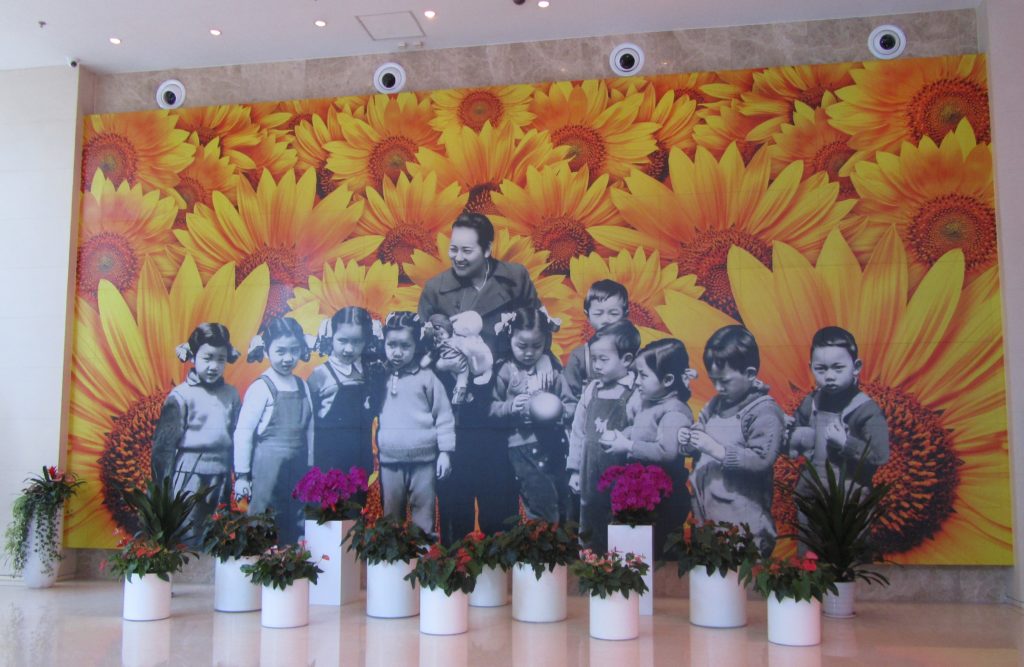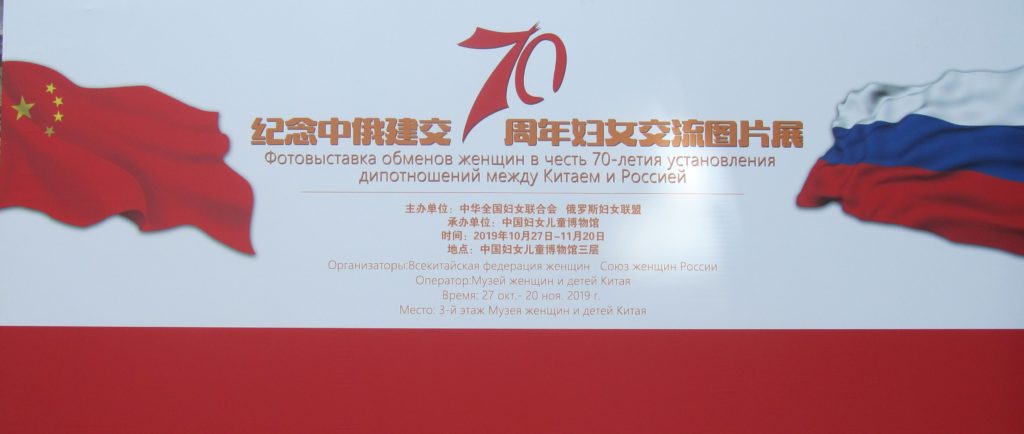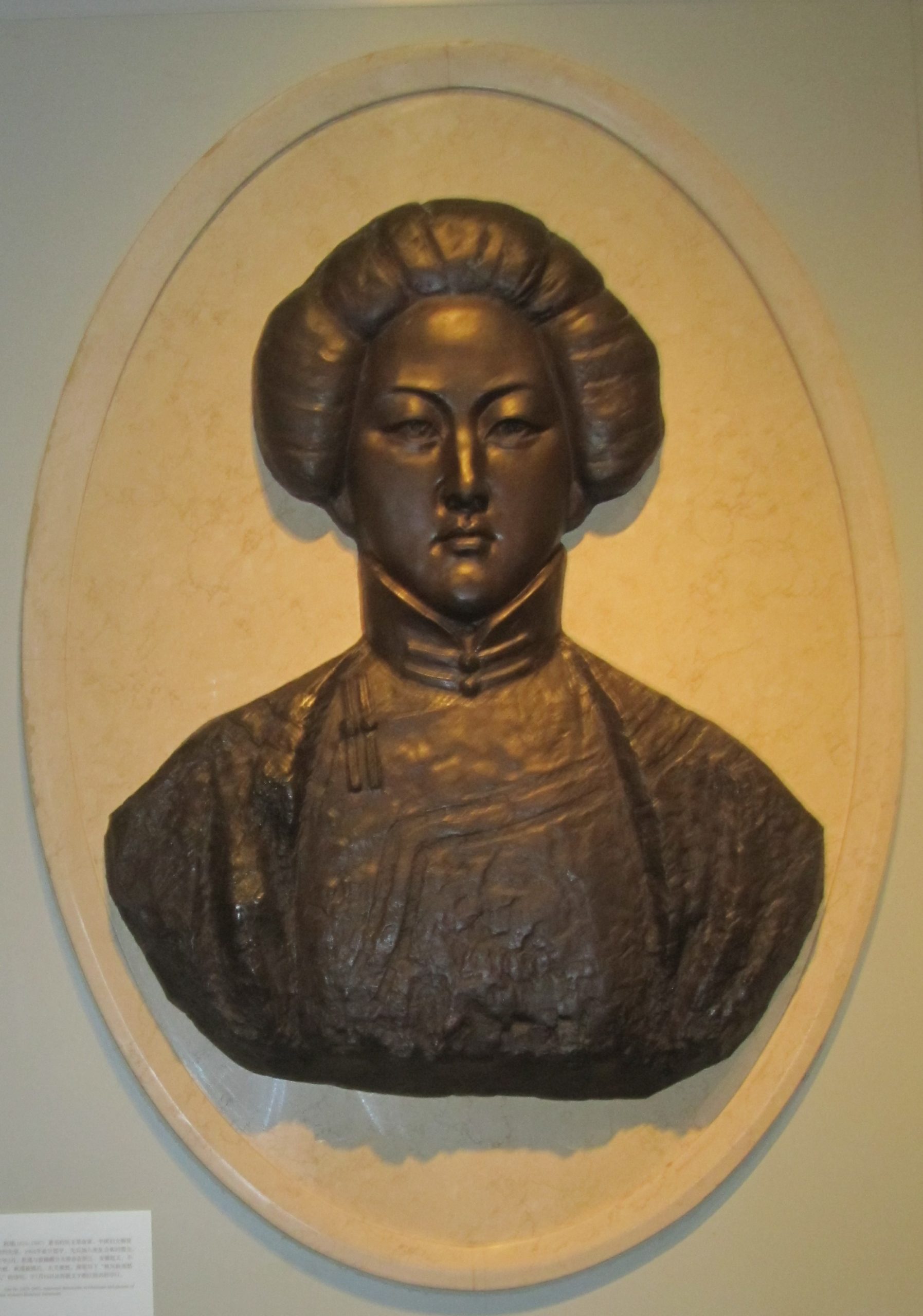Six bus stations followed by just as many subway stations- and now? “Exit B – Women’s Museum“ – the ideal notice presented at the right spot for everybody not familiar with the area. You immediately know where it is best to exit the huge subway system with its plenty of possibilities to do so. After some meters above ground a pair of vigilant eyes recognize that I am a stranger searching for something. A lady helps me to find my way to the museum. It is a huge 6-storied building, in which the museum covers a total floor area of 35 000 square meters. In other words: 7 soccer fields for a women’s museum.

China National Museum of Women and Children, No. 9, Beijige Road, Dongcheng District, Beijing / CHINA, www.ccwm.org.cn
With my ticket from the ticket counter I move to the entrance. Here I have to pass through the security check, a procedure, that meanwhile I am used to from the subway stations. After the impressive outside of the building a huge picture in the entrance hall attracts my attention. It covers a whole wall and refers to the two focal themes of the museum, women and children – both integrated in the museums name as well. I guess it is easier to separate the egg-yolk from the rest than to get rid of the idea that women by nature and exclusively are the ones, who have to care for kids. Referring to this China does not make an exception. From above of the picture, I notice four surveillance-cameras, staring at me and keeping track of my first steps within the building.

As I was not able to get in contact with the museum beforehand, I try another attempt in English at the service desk. With a big smile the lady answers in Chinese. It`s a pity, we cannot understand each other. In a second effort I speak to a person in charge, whom I meet in the special exhibition on the first floor. It fails again. But this time it is not the language. When I ask for a mail-address to get in contact with the museum she points at the web-address and the homepage, displayed on a poster. I already know that they do not offer it there. For me, it feels like there is no interest in providing this information. At least, I get to know that the exhibition here on the first floor deals with the lives of Taiwanese women. As English texts are missing I quickly pass through this section. It is enough for getting the impression that everything is fine for women in Taiwan. “Keep-smiling-faces” everywhere around me. That makes me think of the political tensions between Taiwan and China.

Then I pass by the exhibition halls of the 2nd floor that deal with “Children in China”, but I cannot pass by the Cyrillic characters that point out a photo-exhibition on the 3rd floor. I way too much love the Russian language. At first sight it is obvious that the exhibit celebrates 70 years of relationship between the women of the great powers Russia and China. With my little knowledge in Russian I figure out that it should strengthen and enrich the friendship between the women of both countries. At home I more deeply delve into the texts. I find out that “the relationship stands out for good neighborhood and a hopeful partnership. Russian and Chinese women delegations met and meet each other as good comrades and closely related sisters, exchange ideas and yield important contributions for the development of the bilateral relations.” It goes on like this. First, it takes me some time to consult my dictionary to translate. But once I have made the basic vocabulary my own, I get along quite easily. The typical style of the texts does not change. The past and the future are expressed bombastically but in mere words. Merrily smiling faces back up the texts.
After this sidestep into Russian-Chinese women’s relationships I follow the bright staircase that brings me up to the last floor. From here I intend to go back in women’s history, from the section titled “Into A New Era” to the “Hall of Women in Ancient China”.

While trying to get a first impression, the contents presented triggers the words of an Austrian politician, hidden in my memory. Analogously he said: ”Without the political party I am nobody.“ The same seems to be valid for Chinese women. No development and no achievements without the CPC (= Communist Party of China): “……under the strong leadership of the CPC Central Committee with comrade Xi Jinping at its core……. “. These words form the standard wording that I find many times weaved into the texts like a ritual. Under the protective coat of the CPC, inclusively its patron saint, at the moment represented by Xi Jinping, the development and the achievements of Chinese Women are displayed, as there are: significant improvements in women’s health, dramatic improvements in women’s education, higher economic status of women, basic medical insurance, Anti Domestic Violence Law of the PRC(=People`s Republic of China) 2016,….. The whole spectrum of a woman`s life is covered. Women should face a better environment for their survival and development. They are asked to participate in a green ecological lifestyle to minimize their carbon dioxide-output. They are motivated to practice the core socialist values in their daily lives and to follow the Party by engaging in ideological and political work. To act properly, women’s federations guide women to rally around “the CPC Central Committee with comrade Xi Jinping at its core “. Besides these in the long run extremely boring and never changing songs of praise on the CPC and its “General Secretary of the CPC Central Committee, Chinese President and Chairman of the CPC Central Military Commission“ (- any time mentioned like this –), Xi Jinping`s citations on the other hand refer to his appreciation of women and their big importance in guarding traditional family values and passing them on to the next generation.
Let’s move down to the 5th floor, to the “Hall of Contemporary China”, which covers the time from the foundation of the People`s Republic of China in 1949 upwards. Again, China is presented as a paradise for women: smiling faces on the pictures, the same ritual hymns on the Party, in triplicate:
- the enormous achievements of the CPC for Chinese women
- the fruitful and fighting way women use their talents and abilities within the CPC and thus advance Chinese socialism
- the brilliant and grandiose way the CPC promotes and improves women’s lives in all their aspects
Although the style of praising continues in the “Hall of International Friendship”, it gives me a pause and relieves the monotony of the scenery. It is relaxing to look at the beautiful souvenirs and presents from all over the world. I realize that the majority of the countries presented as friends were members of the former Eastern Bloc or of the former Union of Soviet Socialist Republics. But, what`s this? Within a second a special map of the world strikes me. I remember the first time, when this happened to me, nearly 30 years ago, on my first trip to China. Strolling through the busy streets in order to find a souvenir, I was irritated when I looked at it. It took some time to realize what caused my confusion. It was this special- and for my eyes strange- view on the world. Up to that moment, it was so self-evident to look at our earth as I had learned it in school. Here, different countries formed the center of the world. In the middle of the map there was a huge blue area, the Pacific Ocean, with Australia as the only continent far and wide. I liked it at first sight, because it represents what astronauts with their view from the cosmos describe as “the blue planet“. Then I realized that the central landmark was Asia, with China as its salient country. And what about the others? On the edges of the map – America, North and South, on the right hand side, Africa on the left and Europe on the upper left – all of them fringe areas of the world and distorted because of their position. We “Westerners“ seemed to be insignificant. With the next earthquake we probably would skip from the planet, anyway. In the end I bought this special view on the world, mainly for its eye-opening effect. From that time onwards I am very aware of the fact that all is a matter of perspective, inclusive my impressions here in the women’s museum.
In addition, the Hall of International Friendship deals with the contributions of Chinese women to world peace, their participation in international symposiums and UN-conferences and the engagement of Chinese women in the so-called developing countries.
With the hope of leaving the realm of hymns and praising songs, I step down to the 4th floor and its history before the foundation of the People`s Republic of China. Indeed, it is getting better, although it does not work totally without them, because the CPC was already founded before, in 1921. Anyway, for me the most interesting period of time lies before this date. In the “ Hall of Women in Modern China“ I get some hints on early feminists that mobilized for women’s rights and education. In the section “From the Opium War 1840 to the Revolution 1911“ I meet one of them. Qiu Jin (1875 – 1907) is presented as a heroine of the Revolution of 1911. I already know her from the book The Daughters of Mulan. The author Bettine Vriesekoop designates her as the 1st Chinese feminist of pre-modern China. She was a very brave, intelligent and fighting woman. It is a pity, that the museum only gives little information about her.

As there are so many interesting details about her life, I at least want to give some insight into it, referring to Vriesekoops book:
Qiu Jin was a convinced feminist, dressed like a man and did not care about traditional and conventional manners set up for women. She fought against the arranged marriage of women, against footbinding and the poverty of people. She also fought against the corrupt regime, especially against the widow of the emperor, Cixi. She engaged in good education for girls to enable them to live an independent life. Qiu Jin was accused of having left her children and husband, of having studied in hostile Japan and of planning an attack on the imperial government. In the end she was beheaded. Therefore she is celebrated a heroine by the Communist Party. Accordingly, the museum in my eyes presents her much more as a heroine and a martyr than a feminist. As a self-willed, westerly dressed person that did not submit to anybody, she does not fit into the communist way of thinking. It strengthens my impression, that women are celebrated only if they engage for women’s concerns within the Party. I guess, that this is one of the reasons that the museum much more focuses on the “ New Cultural Movement“ and the “Movement of May 4th“ that after the Revolution of 1911 fought for self-determined marriage and the opening of the universities for women.

Qiu Jin, renowned democratic revolutionist and pioneer of Chinese women’s liberation movement
As I already intensely dealt with the Comfort Women’s Museums (in Japan, South Korea and Taiwan), I was very interested how this topic is presented here. What does the museum transmit about the time of the 2nd Chinese-Japanese-War (1937- 1945)? I am disappointed that I only find some photos that give evidence of women, captured and raped by Japanese soldiers. And there is a sketch of a “comfort house“. The main focus sheds light on heroically fighting women during the defensive-battle against the Japanese aggressors. Besides you get to know about the cultural life during the war against Japan.
For a relaxing intermission I now stroll through some rooms that display very beautiful and wonderful textiles from China.
Then I enter the second floor that is dedicated to the children of China. Here again I run into the glorious achievements and efforts of the CPC. The only difference: instead of referring to women everything refers to children. You already know it: improvements in healthcare, education, social welfare,…I put aside the details and I am sure that I do not miss much. It goes without saying that the young generation heroically joined the defensive-battle against the Japanese,… raising children emphasizes on ethic and moral principles, …motto of the Chinese government nowadays: “kids first…our young masters”, the young Chinese Pioneers as an organization… That’s too much for me, I am at the end of my tether.
Marianne Wimmer, collector of women’s museums
Previous article: From the streets of Shanghai to the Women’s Museum in X’ian